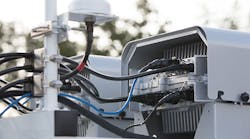Long-Term-Evolution (LTE) technology continues to find non-smartphone applications, as recent testing by General Dynamics has demonstrated. Supported by the Public Safety Communications Research Program (PSCR), the General Dynamics Mission Systems team tested the high-sensitivity Band Class 14 eNodeB for long-range LTE communications. Used in combination with vehicle-mounted modems, the eNodeB successfully operated at ranges up to 67 miles.
This technology has the potential to help emergency first-responders in rural areas and by providing critical information in areas where a network infrastructure is not fully built out. During the test, the equipment operated at two power levels: a standard 23-dBm modem and a 31-dBm vehicle modem. Such long-range communications are an integral part of FirstNet’s National Public Safety Broadband Network, which decreases operations expense and provides more coverage and capabilities for public safety users.
The testing is part of PSCR’s Phase 2 boomer-cell testing, which builds upon Phase 1 and the demonstration range of Band Class 14 LTE. PSCR is a joint program from the National Telecommunications and Information Administration’s (NTIA) Institute for Telecommunications Sciences and the National Institute of Standards and Technology’s (NIST) Communications Technology Laboratory. General Dynamics Mission Systems continues to work with PSCR to demonstrate technical interoperability.
